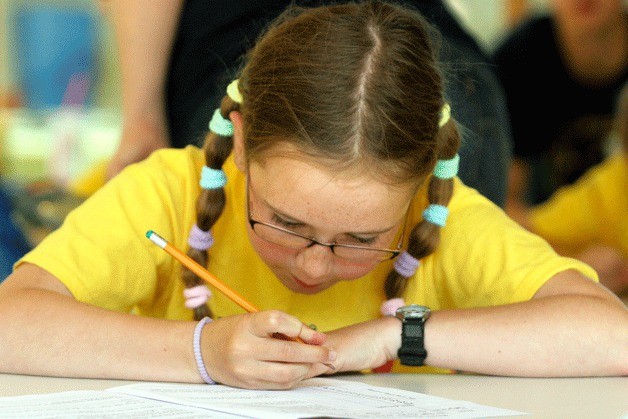It would take a bit of creative thinking and scientific study to save the planet’s tiniest and tastiest “endangered species.”
By the end of last week, though, a great group of Bainbridge youngsters had come up with plenty of STEAM-powered solutions.
Building on last year’s success, Bainbridge schools hosted two STEAM (science, technology, engineering, art and math) camps over the past two weeks for kids who’ll be entering second through seventh grades next year.
Greg Moncada, the STEM (Science, Technology, Engineering and Math) coordinator for the Bainbridge Island School District, said more than 150 students enrolled in the two camps, with 88 of those participating in the elementary STEAM camp that kicked off July 22 at Captain Charles Wilkes Elementary.
Throughout the camp, students were ensconced in a head-spinning array of hands-on activities that included robots, rockets, water balloons and art projects — as well as a “morning spectacular” event that started each day.
“The second morning we did potato cannons and this morning we did high pressure water rockets. And tomorrow morning we are going to do hovercrafts,” Moncada said.
The big events each morning were tied into the theme of the camp, “Building our Future on Earth and in Space.”
But Moncada said the mission for the four-day summer camp was much sweeter.
“It is an attempt to help transport gummy bears off the planet, because they are an endangered species,” Moncada said.
The bears’ own attributes are what put them at risk, he added.
“They are delicate, fruity flavored, and it keeps them from surviving very well in this world,” he said.
The potato cannon, for instance, was used to send gummy bears into a low Earth orbit.
Sure, the setup may seem a little silly, but the gummy bear premise captured kids’ imaginations and opened up a world of possibilities for activities at the camp, from learning how things float or fly to what the future on earth — or beyond — may look like in the future.
While students in one classroom learned how to program LEGO Mindstorms NXT robots and send them on missions, just down the hall at Wilkes, Caro Wilding, a teacher from Commodore Options School, led soon-to-be fourth-graders through an exercise to create a “beach plastic data table.”
Wilding explained how scientists collect data, and how information should follow a similar format so it could be useful to others studying the same things.
At the center of Wilding’s morning exercise were art collages created by the Clark family from plastic trash they found while combing Bainbridge beaches.
“Since we don’t have time to go to the beach today, we’re going to use their beach collection as a way for us to create an inventory of what kind of things are ending up in our oceans and on our beaches,” she explained.
Wilding noted that each artful display of debris could have been constructed by toss-aways anywhere.
“It’s becoming a huge problem worldwide,” Wilding said.
“This could be beaches in Africa. This could be beaches in France, beaches in China, beaches in Japan,” she told the students.
Each table picked an item and the kids began their inventories. Students scooted from table to table, looking for things such as beach toys, bottle caps, food containers, firework debris and other plastic trash.
They soon discovered the most common plastic item to wash ashore: food containers. The least? Beach toys.
Camper Maddy Goodro said she was surprised to learn how long plastic sticks around.
“I thought it took like millions of years,” she said.
“It never decomposes,” Maddy said.
The STEAM camp for older students was held this week at Woodward Middle School.
Kids didn’t launch gummy bears into space, but the kids did send a Barbie skyward. The first flight was via an old clay pigeon thrower; the second launch came from a water-balloon slingshot; and the last, which sent Barbie hurling through the sky and to the other side of the school parking lot, was by a trebuchet, a type of catapult that may date back as far as the 5th century B.C.
In addition to the students in the two camps, another
60 took classes in model rocketry and 3D graphics. The graphics course was a runaway hit, with 30 students, Moncada said.
“The kids live and breath digital media. And they know and understand what it takes to make these backgrounds and these animated characters and they want to participate, they want to be able to do that themselves.
“These kids have a real interest and a talent and they want to pursue that,” he said.
The school district’s STEM initiative is funded by a grant from the Bainbridge Schools Foundation, and the foundation also provided financial aid for students who wanted to attend this summer’s camps.
Moncada said the feedback from the camps, from students and parents, was rewarding.
“I don’t have, ‘I’m bored.’ Reports from parents are, ‘My child is so excited. And so tired,’” he said.
“I had a parent come in today and say, ‘I’m so sorry it ended,’” he said.



